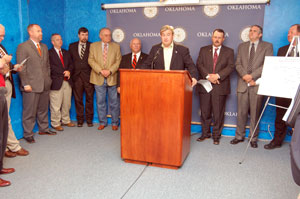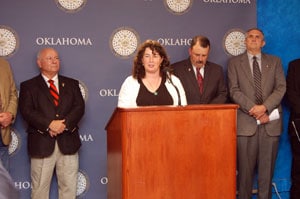Oklahoma’s 2012 Water Quality Success Stories
The Oklahoma Association of Conservation Districts and the Oklahoma Conservation Commission held a joint news conference to announce 11 new success stories in improving the state’s water quality. The press conference was held at the Oklahoma state Capitol on May 7, 2012.

Monitoring and assessment efforts by the Oklahoma Conservation Commission (OCC) have led to the proposal to add 11 Oklahoma streams to the U.S. Environmental Protection Agency’s (EPA) Nonpoint Source Success Stories. Upon approval by EPA, these 11 will join the 16 existing Oklahoma stories highlighted on EPA’s website at: http://www.water/epa.gov/polwaste/nps/success319. These 11 streams are located in nearly every area of the state and are the result of voluntary participation in conservation programs offered through partnerships among local, state and federal entities. OCC’s Water Quality Monitoring Program measured improved water quality in the streams, including decreased turbidity, higher oxygen content, reduced fecal bacteria contamination and reductions in visible oil and grease, according to Shanon Phillips, OCC’s Water Quality division director. Phillips also stated that in the latest EPA review, Oklahoma is number one in the nation for nutrient reductions for 2011.
The steams announced today are the following:
- Pennington Creek, Johnston County
- Stinking Creek, Caddo County
- Tepee Creek, Kiowa County
- Salt Creek, Lincoln and Creek Counties
- Camp Creek, Lincoln and Creek Counties
- Lagoon Creek, Pawnee and Creek Counties
- Turkey Creek, Woods County
- Doga Creek, Osage County
- Beaver Creek, Kay and Osage Counties
- Duck Pond Creek, Beaver County
- Clear Creek, Beaver County
Oklahoma’s conservation partnership, including the USDA Natural Resources Conservation Service (NRCS), local conservation districts and OCC, works with farmers, ranchers and other landowners to address streams with water quality challenges through voluntary, locally-led implementation of best management practices. However, the success of this partnership would not be fully evident without the additional partnership of EPA, who provides the funding through Clean Water Act Section 319 to enable this water quality monitoring.
Jim Reese, Oklahoma Sec. of Agriculture, credited the Oklahoma’s strong water quality monitoring program for effectively documenting water quality improvement. Approximately 500 streams statewide are monitored on a rotating basis by OCC. The resulting data is assessed using state rules to determine if waterbodies are attaining water quality standards or are impacted by pollutants, particularly those from nonpoint or diffuse sources.
“It is those monitoring and testing efforts that give proof to the efforts that landowners are making though these voluntary programs,” Sec. Reese said.
“Effective implementation is key to the success of our nonpoint source management program in Oklahoma,” said Mike Thralls, OCC executive director. “Voluntary participation by landowners, with assistance from state and federal cost-share programs, puts best management practices on the ground that improve water quality while preserving agricultural production interests. The positive, documented results of the conservation partnership’s efforts on water quality are many and have set Oklahoma apart as a leader among programs nationally,” Thralls said.
Also speaking at the press conference were state Sen. Ron Justice; Rep. Don Armes; Ron Hilliard, USDA Natural Resources Conservation Service state conservationists; and Joe Parker and Clay Pope, president and executive director, respectively, of the Oklahoma Association of Conservation Districts. Also participating but not speaking were representatives of the Oklahoma Farm Bureau, Oklahoma Farmers and Ranchers, Oklahoma Cattlemen’s Association and other farm and ranch organizations.

OACD Executive Director Clay Pope 
Rep. Don Armes
Sen. Ron Justice 
Sec. of Agriculture Jim Reese
OCC Executive Director Mike Thralls 
NRCS State Conservationist Ron Hilliard
OACD President Joe Parker 
OCC Water Quality Director Shanon Phillips
